This month in the bread baking blog, we’ve been focusing on artisan breads. Today, we made Italian Semolina Bread using the Artisan Bread in Five Minutes method.
Semolina (Durum) is a high-protein wheat flour that is used in pastas. In these free-form loaves, the semolina flour is paired perfectly with the sesame seeds to provide a wonderful aroma and flavor.
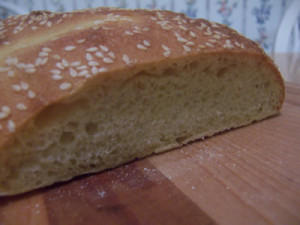
I really like this method. It simplifies the bread making process by reducing the amount of hands-on preparation time and the rising time required to make beautiful artisan loaves. It truly is artisan bread in five minutes.
You might enjoy some of these other Italian Bread recipes.
Italian Semolina Bread
Makes: Four 1-pound loaves.
You can easily double or halve this recipe.
I used 1 pound of the dough for this recipe. I was going to make Armenian Lavash with the rest of the dough, but we’re making Lavish in the Bread Baker’s Apprentice Challenge so I decided to make a no knead deep dish pizza instead.
Ingredients:
- 3 cups lukewarm water
- 1 1/2 T granulated yeast (2 packets)
- 1 1/2 T Kosher salt
- 3 cups Durum flour
- 3 1/4 cups unbleached all-purpose flour
- 1 to 2 tsp Sesame seeds for sprinkling on top
- Cornmeal for dusting the pizza peel (I used parchment paper)
- Cornstarch wash
Directions:
Mixing and Storing the Dough
Mix the yeast and salt with the lukewarm water in a 5-quart bowl, or a lidded food container. Mix in the flours without kneading. This dough is very easy to work with so I used my favorite wooden spoon to mix it, however, you can use a food processor or heavy stand mixer if you prefer.

If the dough gets too hard to stir with the spoon, just wet your hands and reach in the container (or bowl) to incorporate the last bit of flour (but don’t knead it). I like to use the Danish dough whisk for this part. It works really well without having to mess up my stand mixer or my hands.
Cover the dough and allow it to rest at room temperature until the dough rises and collapses, approximately 2 hours.
You can use the dough after the initial rise, however, it is easier to handle when it’s cold. Refrigerate in a lidded container and use over the next 14 days. I put the dough in the refrigerator and left it overnight and for most of the next day.
Shaping the Loaves
When you’re ready to bake, take the dough out of the refrigerator and dust it with flour and cut off a 1-pound (grapefruit-size) piece.
I decided to weigh the dough to see if the piece I cut off was close to 1 pound, and it was. I only had to add a wee bit more dough to make 1 pound.
Dust the piece with more flour and shape it into a ball by stretching the surface of the dough around to the bottom on all four sides, rotating it as you go.
Elongate the ball to form an oval-shaped free-form loaf. Transfer the dough to a pizza peel covered with cornmeal-dusted parchment paper and allow it to rest and rise for 40 minutes.
Baking the Loaves
About 20 minutes before you’re ready to bake the bread, preheat the oven to 450°F. Place a baking stone on the middle rack and an empty broiler tray on the shelf below it. This setup seems to work the best for my oven so the bread browns on top without burning on the bottom.
Just before baking, paint the surface with cornstarch wash. Sprinkle with sesame seeds.
Slash the surface diagonally, using a serrated bread knife. I usually use my lame for this, but the serrated knife seems to work well so I decided to use it instead.
Slide the loaf (with the parchment paper) directly onto the hot stone. Pour 1 cup of hot water into the broiler tray, and quickly close the oven door. Bake for 30 to 35 minutes, until deeply browned and firm. If you have a smaller or larger loaf, adjust the time accordingly. I rotated the loaf a couple of times to make sure it baked evenly.
Cooling and Slicing the Loaves
Allow the loaves to cool on a wire rack before slicing or eating.
Here is the finished and cooled loaf of Italian Semolina Bread.

Storing the Bread
To store the bread, place it in a plastic bread bag. It will keep for a few days.
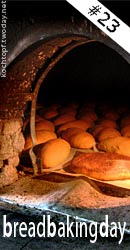
Bread Baking Day #23
I submitted this bread as my entry in Bread Baking Day #23: “Something You’ve Never Made Before”. I’ve never made Italian Semolina Bread before and it tastes great so I think that’s a good reason to enter it.
For more information on Bread Baking Day #23 click here.
Look at all of the beautiful breads in the Bread Baking Day #23 Roundup
Happy Baking!
Cathy
Cathy
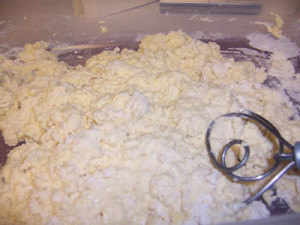
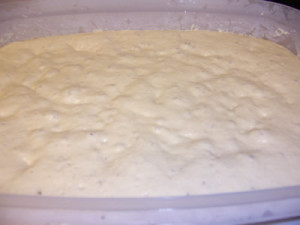
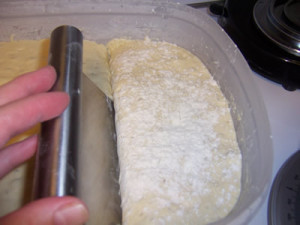
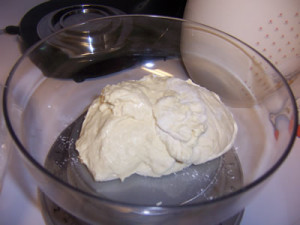
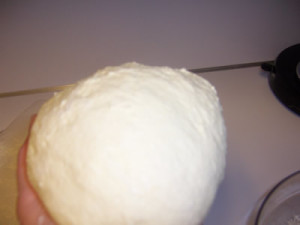
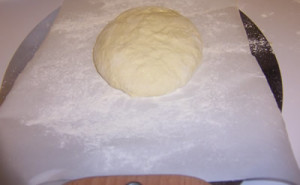

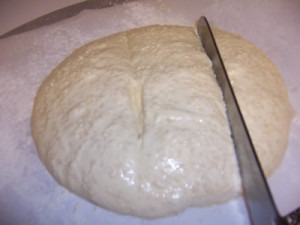
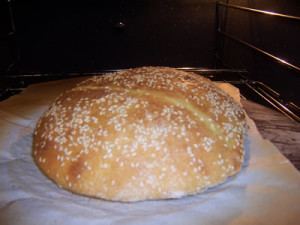
Sara says
That is a beautiful loaf, I just love making these rustic italian breads. Thanks for joining us for this month’s BBD!
Doug says
Just made this bread, made half as baguettes, half as round loaves. Absolutely delicious ! Thanks for the excellent, easy to follow directions !
Cathy (breadexperience) says
Thanks Doug! So glad you enjoyed it.
Doug (a different one) says
Thinking about trying this recipe for Christmas, but wondering whether the baking stone is absolutely required (mine cracked years ago). Would a baking sheet be an OK substitute?
Cathy W. says
Hello Doug, you can bake this on a baking sheet instead of a baking stone. It won’t have the same results – i.e. crispy crust, but it should be okay. Just make sure the oven is preheated sufficiently. You might want to spritz the loaf lightly with water to create steam during baking.